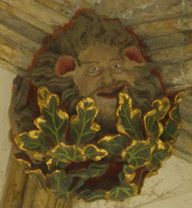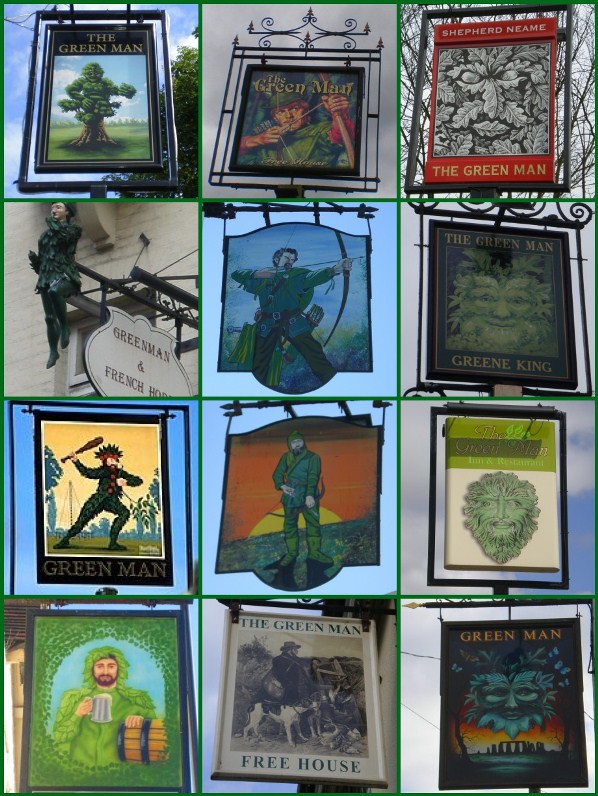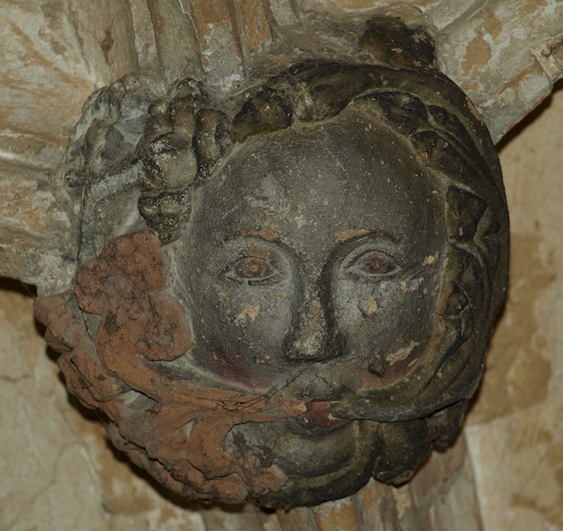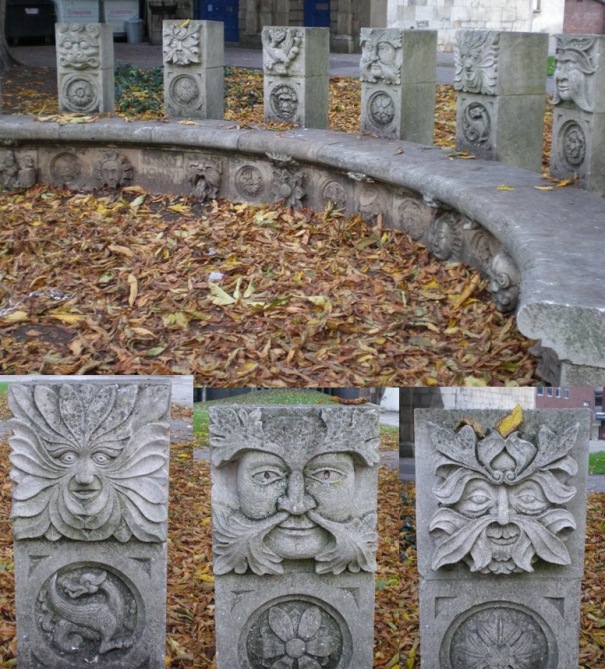Many Green Men and One Green Lady
by Esmerelda Weatherwax (October 2010)
As you know I take an interest in pub signs of England, churches, and all sorts of other stuff. A popular name for a pub (less so since the advent of chain pubs all called Slug and Lettuce, or the Hogshead) is the Green Man. Further, the green man (as they are currently called) is an architectural feature ancient and modern.
Gloucester is so enthusiastic about foliate heads that over the centuries the Cathedral has commissioned new carvings. There are Victorian and 20th century carvings on the West Front. Very recently the Dean and Chapter and the City Council organised and funded the Storytellers bench in the grounds of St Mary le Crypt church which is the home of the National Centre for the Spoken word. This is a lovely project for children set near the local library, from which I hope generations get hours of enjoyment and inspiration.
 The history of the foliate heads can indeed be traced back into to pagan history in that they are believed to have derived from the dignified leaf masks of late Roman art, which depicted Gods like Silenus. They became part of the repertoire of carving belonging to the style known on the continent as Romanesque which was introduced to England by the Normans. From the 12th century they became ever more varied and subtle, combining as they did two of the fascinations of the medieval artist, foliage and the human face. Some of the heads are animals, real or heraldic. This gentleman from Norwich to the left reminds me of Shrek.
The history of the foliate heads can indeed be traced back into to pagan history in that they are believed to have derived from the dignified leaf masks of late Roman art, which depicted Gods like Silenus. They became part of the repertoire of carving belonging to the style known on the continent as Romanesque which was introduced to England by the Normans. From the 12th century they became ever more varied and subtle, combining as they did two of the fascinations of the medieval artist, foliage and the human face. Some of the heads are animals, real or heraldic. This gentleman from Norwich to the left reminds me of Shrek.
 There is a selection in the photographs below taken by either me, my husband or daughter over the last 2-3 years. So many places, all over England, over an 800 year period, trying to generalise too much could not do it justice. There are foliate heads in medieval glass as well, but I have not seen these personally. Later artists worked in ceramics and man-made materials. Victorian floor tiles of green kings at Rochester cathedral left.
There is a selection in the photographs below taken by either me, my husband or daughter over the last 2-3 years. So many places, all over England, over an 800 year period, trying to generalise too much could not do it justice. There are foliate heads in medieval glass as well, but I have not seen these personally. Later artists worked in ceramics and man-made materials. Victorian floor tiles of green kings at Rochester cathedral left.
Even the colour green is a misnomer. Where the carvings are coloured the leaves are frequently gold or brown (the best examples are in Norwich, in my opinion). They contain acorns or fruit rather than flowers, indicating that the figures are as much about harvest, autumn and fruitfulness, as they are about spring and new life, be that fertility or resurrection.
St Hildegard writing in Latin took great delight in the words vir, virgo, virga viriditas, man, maid, a flowering branch, the power to grow green. The first lines of her Song to the Virgin Mary have been translated as
Hail, O greenest branch, who came forth with the saints, like a gust of wind.
To conclude, this is an enormous subject, of which I have barely scraped the surface and have not even attempted to decide where the Jacks in the Green of Mayday fit in. If, as I believe, the foliate heads and the green and wild men of the woods all come from our natural human appreciation of trees and growing things then they are connected in concept, despite their different recent histories.
I hope the photographs below give an idea of how wide and fascinating the subject is.
Left hand column from top to bottom
The Green Man and French Horn in Covent Garden.
The Green Man, Little Snoring nr Fakenham in Norfolk. I took this from the internet as it is no longer the sign of this pub. The leafy man and his pose is repeated at pubs elsewhere.
The Green Man, Plashet Grove, east London. I had to take this from the Pubsgalore website as the pub was demolished in 2008 and is now a block of flats. The leafy man enjoys a pint of best. RIP.
Centre row, top to bottom. The Green Man represented as that other figure of English legend, Robin Hood who dressed in Lincoln green and lived in Sherwood Forest. Work that out for yourselves. And a modern green man, a countryman in barbour coat, courduroy and green wellies.
The Green Man Edney Common
The Green Man Bradwell Waterside, facing left and right.
The Green Man Six Mile Bottom, Suffolk.
Right hand column from top to bottom. The modern preference for the foliate head.
The Green Man, Takely Street, Essex.
The Green Man Little Snoring, Norfolk 2009. The present sign.

2 A selection of foliate heads. From top to bottom and left to right.
Two from the roof bosses in the cloisters at Norwich cathedral. The lady Chapel of Ely Cathedral.
South Ockenden Parish church Essex, a roof boss removed to the ground in Southwark cathedral, above a door to the Boston Stump.



5 The Storytellers Bench Gloucester.
Detail of individual seats inset at bottom.

Reference works consulted:-
Oxford Dictionary of English Folklore. Pitkin Guide to the Green Man. The Green Men of Gloucester Cathedral. A Little Book of the Green Man by Mike Harding.
For the quotations of St Hildegard of Bingen
The Wisdom of Hildegard of Bingen compiled by Fiona Bowie and Benedictine Tapestry by Dame Felicitas Corrigan.
Photographs E. Weatherwax and family unless stated from elsewhere.
here.
here.
here.
here.